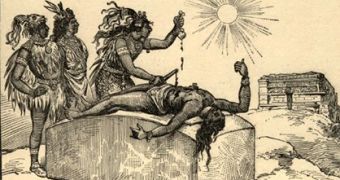With Mel Gibson's "Apocalypto", the most sinister aspect of the indigenous cultures of Mesomerica is revealed: their blood thirst and appetite for human sacrifices.
What a simple DNA analysis revealed shows that the "Apocalypto" scenes are just backyard play.
Ancient indigenous that built the Pyramid of the Moon at the Teotihuacan have been found to have brought human sacrifice victims from hundreds of miles away over centuries to sanctify the edifice.
This pyramid represents the oldest city in North America, just north of Mexico City.
The DNA tests were made on the skeletons of over 50 victims found in 2004 in the pyramid's ruins and showed that the victims came from faraway Mayan, Pacific or Atlantic coastal populations.
Most of the bodies were decapitated and were dated from between A.D. 50 and 500, being sacrificed during various phases of the pyramid building. "The victims were likely either captured in war or obtained through some kind of diplomacy," said archaeologist Ruben Cabrera, leader of the excavation at the pyramid.
The Pyramid of the Moon and its bigger counterpart, Pyramid of the Sun, are the two main edifices at Teotihuacan, which at its peak, around 500, had a population of about 200,000. "Teotihuacan may have had a tradition of capturing prisoners for sacrifice," said Cabrera.
Other indigenous Mexican civilizations like the Aztecs sacrificed human victims by ripping off their hearts out of their chests, but how the victims at Teotihuacan were murdered it is still not known.
Also, the researchers have not identified yet the ethnic group that inhabited Teotihuacan.
But Teotihuacan was worshiped by posterior Mesoamerican civilizations, like the Aztecs, from whose language, Nahuatl, comes its current name, "The place where gods are made".
Teotihuacan icons were found in the remote Mayan ruins in Guatemala and Honduras, revealing the city's influence.
Amongst the human skeletons there were also found bones belonging to animals that possessed mythologic importance, like pumas, coyotes, eagles and snakes, as well as many valuable objects like obsidian knives.
The discovery of the human victims in the early 1980s cut out former theories that Teotihuacan was a peaceful culture, opposite to the warlike Aztecs and Maya. "Researchers always tried to throw a little fog over it, but there was human sacrifice even if we don't know if it had to do with wars," said Cabrera.

 14 DAY TRIAL //
14 DAY TRIAL //